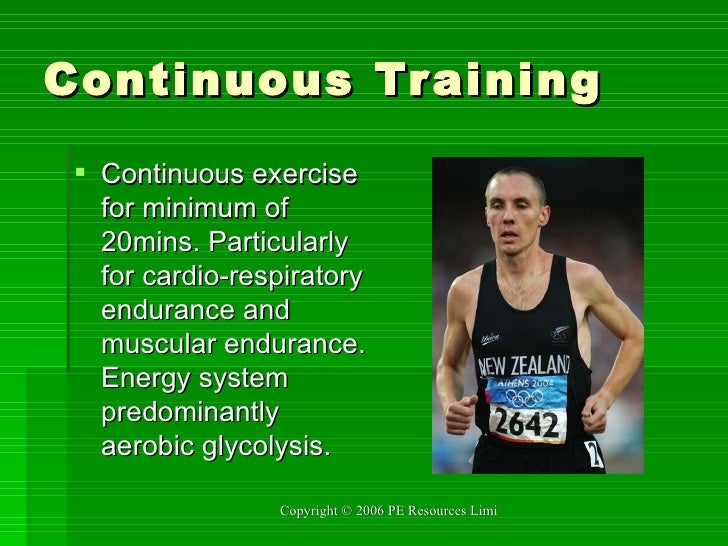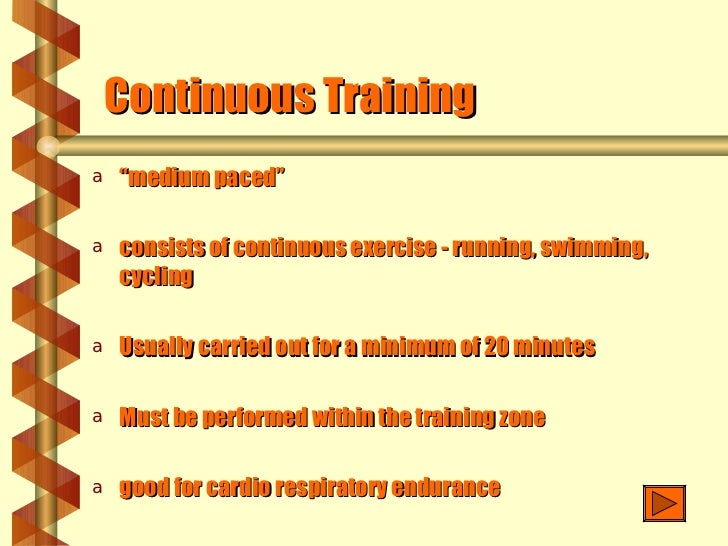
What is Continuous Training? (with pictures)
HIIT has been proposed to be equal or advantageous to continuous endurance training both in terms of physiologic results [7, 8] and in enjoyability . However, the health benefits, risks, and optimal design of HIIT are still unclear. Further, most of the research on the effects and benefits of HIIT has been done in younger and middle-aged adults.

HIIT vs. Continuous Endurance Training Battle of the Aerobic Titans IDEA Health & Fitness
High-intensity interval training imparts the same or greater benefits to the general population as continuous endurance training, namely, in improving V O 2max, quality of life, and metabolic health, among others.

Personal Exercise and Fitness Notes Physical Education Leaving Cert iRevise
Both forms of interval training induce the classic physiological adaptations characteristic of moderate‐intensity continuous training (MICT) such as increased aerobic capacity ( V ˙ O 2 max ) and mitochondrial content.

ENDURANCE CONTINUOUS OR INTERVAL TRAINING?
Adaptations to Endurance and Strength Training. Cold Spring Harb Perspect Med2018 Jun 1;8 (6):a029769. doi: 10.1101/cshperspect.a029769. The capacity for human exercise performance can be enhanced with prolonged exercise training, whether it is endurance- or strength-based. The ability to adapt through exercise training allows individuals to.

Training Principles1
With endurance training, the primary aim is to convert stored fat into energy, a process that requires a lot of oxygen (referred to as aerobic metabolism). HIIT, by contrast, uses both aerobic and anaerobic metabolism to generate energy for workouts.

HIIT vs. Continuous Endurance Training Battle of the Aerobic Titans Yoga lesson plans
In comparison to continuous endurance training (CET), high-intensity interval training (HIIT) is a time-efficient strategy to induce skeletal muscle metabolic adaptations and improve functional exercise capacity ( 29 ).

Training methods
To lower the disease risk, continuous endurance training (CET) such as running, brisk walking or cycling at moderate intensity is the recommended exercise modality, including 150-250 min•wk-1 activity ( Donnelly et al., 2009 ).

12 Crazy Battle Rope Exercises for HighIntensity Interval Training Rope exercises, Battle
A 2019 study published in the Journal of Strength and Conditioning Research found that a 12-week strength training program improved maximal oxygen uptake (VO2 max) in recreational runners. The researchers found that the strength-trained group had a 5.7% increase in VO2 max compared to the control group that did not perform strength training.

PE Poster Top 10 Cardiovascular Endurance Exercises Cardiovascular endurance exercises
These groups were matched based on the required energy expenditure (EE) for completing each protocol: (a) HIIT (10 × 60 seconds at 90% peak oxygen uptake [V̇o2peak], 1: 1 work to recovery at 50 W), (b) CET at an intensity equivalent to maximal fat oxidation (Fatmax) (CETFAT) (pedaling for a duration that expends an equivalent EE to an HIIT sessi.

PPT How does a marathon runner use aerobic endurance? PowerPoint Presentation ID2464427
ek high-intensity interval training (HIIT) intervention, or an isocaloric continuous endurance training (CET) intervention on insulin resistance indices and change in irisin and preptin in patients with prediabetes. Thirty-two prediabetic male patients (age = 38.7 ± 4; body mass index = 26.9 ± 1.4 kg·m−2; and V̇o2peak = 2.49 ± 0.22 L·min−1) were randomly assigned into 3 training.

How Does Continuous Training Improve Cardiovascular Fitness All Photos Fitness
Consistent bouts of endurance exercise such as 30-60 minutes of continuous running or cycling performed 3-7 days per week leads to several other cardiovascular adaptations including the following: 1. Increased cardiac muscle mass 2. Increased stroke volume 3. Increased disposal of metabolic wastes 4. Increased oxidative enzymes and efficiency 5.

Top 10 Benefits of HighIntensity Interval Training • Bodybuilding Wizard
The ability to adapt through exercise training allows individuals to perform at the height of their sporting event and/or maintain peak physical condition throughout the life span.

Forms of endurance training FitnessIndex
(Continuous aerobic training is defined as exercising—running, cycling, swimming, etc.—for more than 20 minutes at a steady intensity.) Also included here are research-based examples of HIIT and continuous endurance training. Cardiovascular Physiology 101: Basic Reponses and Adaptations of Aerobic Training

HIGH INTENSITY OR CONTINUOUS ENDURANCE TRAINING PERFORMED TO PREVENT PREDIABETES ACE Physical
Continuous training is one factor involved in Cardiorespiratory Endurance with the further training methods of Interval Training and Fartlek Training also playing a major role in this important conditioning. Cardiorespiratory; heart and lungs, and their ability to deliver the efficient supply of oxygen to the muscles during periods of sustained.
/cdn.vox-cdn.com/uploads/chorus_asset/file/13681265/shutterstock_1007038000.jpg)
How Does Continuous Training Improve Cardiovascular Fitness All Photos Fitness
Background Enhancing cardiovascular fitness can lead to substantial health benefits. High-intensity interval training (HIT) is an efficient way to develop cardiovascular fitness, yet comparisons between this type of training and traditional endurance training are equivocal. Objective Our objective was to meta-analyse the effects of endurance training and HIT on the maximal oxygen consumption.

2400 CONTINUOUS MOVES for MUSCULAR ENDURANCE workout / LOWIMPACT, NO REPEATS! Good change of
Consistent endurance exercise—such as 30-60 minutes of continuous running or cycling 3-7 days a week—causes a long list of cardiovascular adaptations and responses (see Figure 1). HIIT vs. Continuous Endurance Exercise: HIIT vs. Continuous Endurance Exercise: Cardiovascular Adaptations